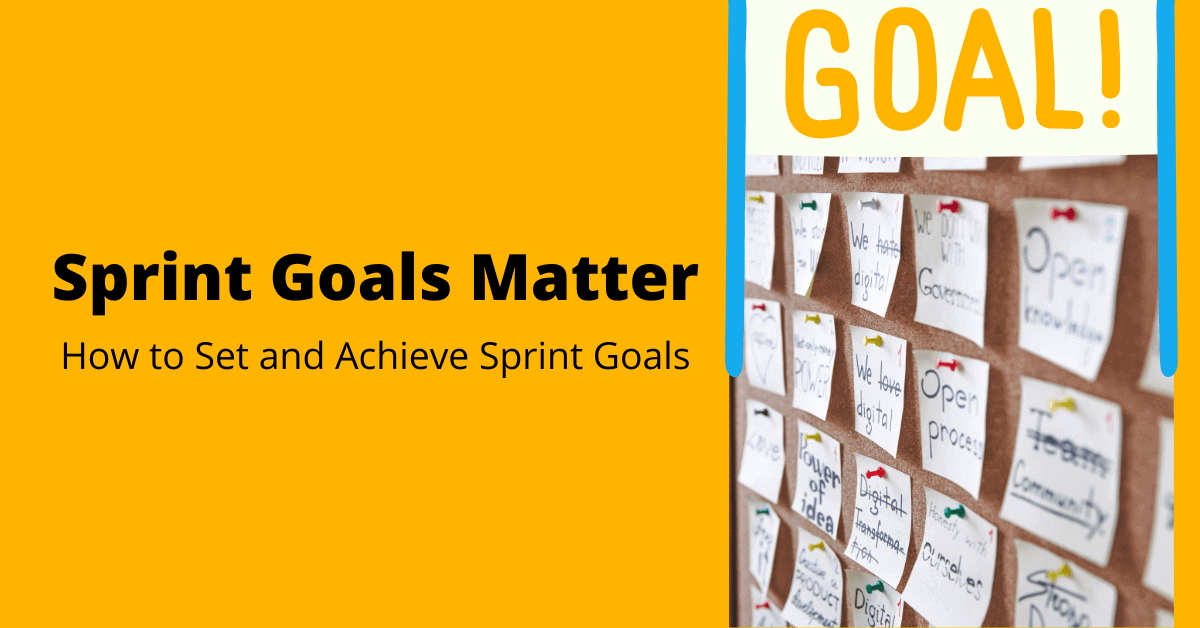|
|
Sprint goals are an essential ingredient in a scrum recipe. They provide a framework and guide for the team as they work towards a common goal. And, as with all things scrum, achieving sprint goals requires organization, focus and discipline. The Sprint goal is created during the sprint planning with the entire scrum team – Scrum Master, Developers, Product Owner.
Related: Getting started with Scrum guide
A good product roadmap and sprint goals tie into achieving your company’s product goals. Here are five tips to help you set and achieve your sprint goals:
1. Define the goal
What do you want to achieve by the end of the sprint? What is the end goal? Once you have answered these questions, you can start to define what it takes to reach that end point. This includes everything from bug fixing to new product development.
The sprint goals should be measurable. It should be able to answer the question – “Why are we doing this Sprint”, succinctly and clearly.
If the team works on a bunch of unrelated product increments in the same sprint then it can be tricky to create a common goal. Take a look at the below examples:
A not good goal would be:
- Improve the user experience
- Make the checkout process faster
Note that the first goal doesn’t tell about how and what and moreover is not measurable. The second goal could be altered to set some metrics around faster.
A good example could be:
- Set up CI/CD – deployment pipeline & release an empty file to production
- Create a widget to automatically show products on UI
- Create an integration that sends data from one system to another system
Remember the sprint goal needs to be clear, concise and measurable. And most importantly, your entire team needs to commit to it.
Related Blog: How to become an efficient and effective Scrum Master
2. Meet your definition of done
The Definition of Done applies to the Increment as a whole and to each user story item that is a part of that Increment. Any work that does not meet this definition in your current sprint backlog is not considered part of the Increment. A mature Agile Team often pays close attention to the technical debt which is embedded into the definition of done. However, there can be instances when you have to make a trade off dealing with technical debt which may affect meeting your definition of done.
Consider the following example – if your goal is to create a widget, what does it mean to have created the widget? Is it coded and working? Is it integrated with other parts of the application? If you can’t answer these questions then you might not be ready to declare the goal as “done.” A sprint goal is not met, till your definition of done is achieved.
3. Set boundaries
As tempting as it may be, don’t try to squeeze too much into a single sprint. Remember – a sprint is designed to produce tangible results, not just increase velocity (the speed at which work is done). Be realistic about timelines and make sure that everyone on your team is aware of them.
If possible Product Backlog Increments can be further broken down into smaller, more manageable tasks. This will help prevent over-commitment and ensure that each task is complete before moving onto the next one. Quite frequently the teams are structured to take up some unplanned work (like Production issues, security vulnerabilities etc) during the course of the sprint. Make sure you do not loose the sight of your sprint goals and only take up unplanned work if the product owner has approved it and not doing the work during the sprint might cause damage to the company.
Bottom line, split your goal into manageable tasks and stick to them!
4. Communicate constantly
Once you have defined the goal, you need to communicate it to your team. This can be done through a scrum charter, sprint planning or daily scrum event. Make sure everyone on your team is aware of the sprint goal and understands their role in reaching it.
Not every task will require visual representation (such as a pictogram). However, keeping track of progress through a system such as JIRA, Azure DevOps or Trello can be extremely helpful in gauging success or failure. No matter how well you plan, things will inevitably go wrong along the way – make sure everyone on the team is kept up-to-date with progress via daily scrum. It is important that team members hold each other accountable and not hesitate to ask tough questions, respectfully.
And finally…
5. Persevere!
Even with careful planning and hard work, things sometimes don’t go according to plan – this is simply part of scrum life (and part of the fun!). Distractions can often make it harder to stick to the goal for an entire sprint. Remember that delivering story points is not a measure of success but value delivery is.
Don’t get discouraged – keep plugging away, and eventually you’ll reach your goal!.
Conclusion
A good sprint goal enables efficient decision-making and contributes towards a valuable outcome. Remember the objective of a sprint should be to achieve the goal even if you are not able to complete all the sprint product backlog items. In case the sprint goal is not met, the Agile Team should talk about it in their Sprint Retrospective event. Adaptability allows you to change your plans and adapt them to new situations.
Scrum on!!
Further Reading
Prepare for PSM-I certification with free tips, resources and more
Blogs

